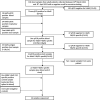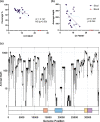Multiplex MinION sequencing suggests enteric adenovirus F41 genetic diversity comparable to pre-COVID-19 era
- PMID: 36748435
- PMCID: PMC9973849
- DOI: 10.1099/mgen.0.000920
Multiplex MinION sequencing suggests enteric adenovirus F41 genetic diversity comparable to pre-COVID-19 era
Abstract
Human adenovirus F41 causes acute gastroenteritis in children, and has recently been associated with an apparent increase in paediatric hepatitis of unknown aetiology in the UK, with further cases reported in multiple countries. Relatively little is known about the genetic diversity of adenovirus F41 in UK children; and it is unclear what, if any, impact the COVID-19 pandemic has had on viral diversity in the UK. Methods that allow F41 to be sequenced from clinical samples without the need for viral culture are required to provide the genomic data to address these questions. Therefore, we evaluated an overlapping-amplicon method of sequencing adenovirus genomes from clinical samples using Oxford Nanopore technology. We applied this method to a small sample of adenovirus-species-F-positive extracts collected as part of standard care in the East of England region in January-May 2022. This method produced genomes with >75 % coverage in 13/22 samples and >50 % coverage in 19/22 samples. We identified two F41 lineages present in paediatric patients in the East of England in 2022. Where F41 genomes from paediatric hepatitis cases were available (n=2), these genomes fell within the diversity of F41 from the UK and continental Europe sequenced before and after the 2020-2021 phase of the COVID-19 pandemic. Our analyses suggest that overlapping amplicon sequencing is an appropriate method for generating F41 genomic data from high-virus-load clinical samples, and currently circulating F41 viral lineages were present in the UK and Europe before the COVID-19 pandemic.
Keywords: DNA virus; adenovirus; genetic epidemiology; genomics; hepatitis; virology.
Conflict of interest statement
The authors declare that there are no conflicts of interest
Figures




Similar articles
-
Clinical characteristics and phylogenetic analysis of human enteric adenovirus type 41 (HAdV-F41) from children with gastroenteritis during SARS-CoV-2 pandemic.Infect Genet Evol. 2024 Sep;123:105619. doi: 10.1016/j.meegid.2024.105619. Epub 2024 Jun 19. Infect Genet Evol. 2024. PMID: 38906518
-
An adenovirus type F41 outbreak in a pediatric bone marrow transplant unit: analysis of clinical impact and preventive strategies.Pediatr Infect Dis J. 2008 May;27(5):419-24. doi: 10.1097/INF.0b013e3181658c46. Pediatr Infect Dis J. 2008. PMID: 18382384
-
Adeno-Associated Virus 2 and Human Adenovirus F41 in Wastewater during Outbreak of Severe Acute Hepatitis in Children, Ireland.Emerg Infect Dis. 2023 Apr;29(4):751-760. doi: 10.3201/eid2904.221878. Emerg Infect Dis. 2023. PMID: 36957994 Free PMC article.
-
Pathogenicity and virulence of human adenovirus F41: Possible links to severe hepatitis in children.Virulence. 2023 Dec;14(1):2242544. doi: 10.1080/21505594.2023.2242544. Virulence. 2023. PMID: 37543996 Free PMC article. Review.
-
Hepatitis of unknown aetiology in children - epidemiological overview of cases reported in Europe, 1 January to 16 June 2022.Euro Surveill. 2022 Aug;27(31):2200483. doi: 10.2807/1560-7917.ES.2022.27.31.2200483. Euro Surveill. 2022. PMID: 35929429 Free PMC article. Review.
Cited by
-
'Vivaldi': an amplicon-based whole-genome sequencing method for the four seasonal human coronaviruses, 229E, NL63, OC43 and HKU1, alongside SARS-CoV-2.Microb Genom. 2025 Jul;11(7):001451. doi: 10.1099/mgen.0.001451. Microb Genom. 2025. PMID: 40663464 Free PMC article.
-
Multispecies Cocirculation of Adenoviruses Identified by Next-Generation Sequencing During an Acute Gastroenteritis Outbreak in Coastal Kenya in 2023.Open Forum Infect Dis. 2024 Sep 3;11(9):ofae505. doi: 10.1093/ofid/ofae505. eCollection 2024 Sep. Open Forum Infect Dis. 2024. PMID: 39319086 Free PMC article.
-
Molecular Epidemiology of Human Adenovirus from Acute Gastroenteritis Cases in Brazil After the COVID-19 Pandemic Period, 2021-2023.Viruses. 2025 Apr 17;17(4):577. doi: 10.3390/v17040577. Viruses. 2025. PMID: 40285019 Free PMC article.

